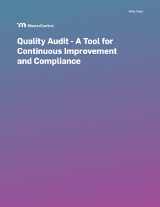
GxP Lifeline
Creating a Lean Culture of Continuous Improvement in Manufacturing
One summer evening my sweetheart and I chose to go a locally owned burger place. After we’d received our order and took our first bites, my wife was in bliss while I was confused. My burger included a locally made bun, fresh lettuce, juicy tomato, crisp pickle, and no meat. The main event was missing! Like the 1980s Wendy’s commercials I was left saying their famous tagline, “Where’s the beef?”.
Fortunately, the workers were also shocked and quickly fixed the situation. Let me tie this back to quality. Instead of a burger, imagine the “main event” you’ve been looking forward to is a better corporate quality culture. What’s your “beef?” Are you introducing new software to drive lean manufacturing? Maybe you’re opening a new digital library to teach your manufacturing employees about new continuous improvement methods? To avoid missing “beef,” some thought and care need to be taken to ensure long-term success.
Getting Buy-In for Lean Manufacturing and Continuous Improvement Software
One of the biggest hurdles you’ll need to clear is selling your continuous improvement software or lean manufacturing to your team. Preparing a document or presentation to do this can help you put your vision down in writing so it’s easier to explain to your team. Try describing things like:
- What you want to do.
- Why you want to do it.
- How your team is going to do it.
- The benefits your team can expect to see.
6 Steps to Gaining Acceptance for Continuous Improvement Changes
Once you’ve begun transforming your vision into an idea you can clearly share, you’ll want to make a case for the lean manufacturing or continuous improvement changes you’re wanting to make. Following this six-step process will help produce approval while convincing employees of the need for change:
- Articulate the case for the change.
- Prepare a vision of what it will be like after the change.
- Identify skills needed to make the change.
- Define incentives for the change.
- Identify the resources to implement the change.
- Have an action plan.
Think of doing these things as the bun, pickles, lettuce, and cheese. All these elements improve the taste of the burger and take it beyond basic. Managing complex change requires all these elements for success. Missing just one will lead to employees feeling confused, anxious, resistant, frustrated, or that they are on a continuous improvement treadmill going nowhere.
Beginning Integration With a 6 S Program
You’ve got your bun prepped with your favorite condiments, the sides are warm and ready. What we need now is the burger right, we don’t want that to be missing for your employees like it was for me. The way to make sure the introduction and adoption of your lean manufacturing or continuous improvement software is to develop a 6S program. Having a 6S program gives you a way to introduce the culture of lean manufacturing and continuous improvement before layering in the complexity that comes with software.
The 6S program has been diagrammed a few different ways. Sometimes as an improvement cycle and other times like a home. In either diagram method, each part or step is important and relies on the other parts to be successful. In some textbooks you may see this also called 5S. The original 5 Ss are:
- Sort.
- Set in order.
- Shine and inspect.
- Standardize.
- Sustain.
The sixth S I’ve added to this process is Safety.
Not only does 6S sound like success, it’s also impossible to have success when developing continuous improvement manufacturing culture without involving safety. I’m talking about not only keeping you and your employees physically safe but also mentally safe. Workers who act and feel safe will be more engaged in their work, more attentive to the tasks they’re performing, and they will create less human-caused scrap and defects.
Next, I apply Maslow’s Hierarchy of Needs to the 6 Ss you’ve listed out. These needs are normally shown in a pyramid chart. The top is self-actualization, followed by esteem, belongingness and love, safety, and finally the large base of the pyramid being physiological needs. Being an ‘80s kid and loving to fit things together Tetris-style, I turned Maslow’s pyramid then upside down and placed it evenly between the 6S chart.
With these charts now side by side visualize the connection between the two. This is the “beef” you don’t want to leave out. When an employee’s self-actualization needs are being met, there’s high morale, motivation, fulfillment, creativity, friendships, and confidence. Employees will engage in fewer at-risk behaviors, find themselves in fewer dangerous situations. Not only does this create a safer place to work it also gives the Power Users introducing your new continuous improvement software more opportunities to be welcomed and accepted as mentors and teachers who can then inform on configuration, software process steps, and menu navigation.
Applying a 6S Approach to Continuous Improvement Software and Lean Manufacturing Process Implementation
Whether you’re a formal or informal leader, having a 6S program tethered to a hierarchy of needs will bring the safety your team is looking for when introducing new lean manufacturing processes or continuous improvement software. By bringing the “beef” your team won’t be caught by surprise or feel something is missing. Just as author Simon Sinek wrote, “When people feel safe, they work together to face outside dangers and make remarkable things happen. The natural reaction of people who feel safe is to trust and cooperate.” As you implement these processes and meet the physical and mental safety needs of your employees, I know that your organization will enjoy increased success.
Free Resource

Enjoying this blog? Learn More.
Quality Audit – A Tool for Continuous Improvement and Compliance
Get the guide